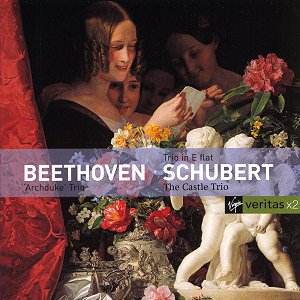The Archduke Trio and Schubert’s E flat Trio
make a good coupling but, substantial masterpieces that they are, their
length precludes a single CD. Virgin’s solution is to produce a double
disc set that includes lesser known works by the composers that are
of interest and provide enjoyable listening.
If anyone needed help in coming to terms with period
instrument chamber music performance, particularly the sound of the
fortepiano, then this disc would be high on my list of recommended listening.
The American Castle Trio uses "period" instruments that were,
strictly speaking, not contemporary in respect of manufacture. Marilyn
McDonald’s Guarneri was made, coincidentally, exactly one hundred years
before Beethoven’s birth and Kenneth Slowik’s Testore a century before
the composition of the Archduke. The fortepiano was made in 1984,
a reproduction of a Graf instrument dating from the later part of Beethoven
and Schubert’s lives. They sound wonderful.
The Castle Trio have taken a view of how the music
might have been played and achieve an astonishing unity of style in
realising it. The strings, played with reduced vibrato, match the clean
percussive sound of the fortepiano so not only is there clarity of texture
but excitement that derives from a sense of clean attack at accents
and double forte passages. But Lambert Orkis still manages to make his
instrument sing in solo keyboard passages. It was in this context that
I nearly had serious misgivings – at the very start of the Archduke
Trio which plunges straight into the main tune for keyboard, Orkis
indulges a hint of vibrato damaging the required sense of forward momentum.
This momentum is needed to offset the chops and changes that are later
built into the music. It is a frequent tendency of Beethoven in his
first movements to falter and probe. It is his way of creating an impression
of building the structure before our ears. However it does pose problems
of interpretation. As luck would have it, the second subject is also
for solo keyboard and Orkis does it again. Now Orkis is a superb player
and I do not want to make too much of this, but as the distinguished
chief accompanist to Ann Sophie Mutter, it will not be the first time
that he has been held to account for this sort of thing. The slight
holding up of momentum has, for example, sometimes been the only critical
comment on otherwise fine Mutter/Orkis performances of the Beethoven
violin sonatas.
It is this that contributes to my feeling that the
performance of at least the first movement of the Archduke does
not quite have that sense of overall progression and structural stability
that the music demands. I do feel those qualities are there with EMI’s
recording of Ashkenazy, Perlman and Harrell from nearly twenty years
ago – one of those good old fashioned modern performances - if you see
what I mean.
The Castle Trio does provide passages of great delight
though. The building of the climax at the end of the exposition in the
Archduke is hugely exciting and its particular sound makes the
scherzo really bounce, particularly in the pounding bits. In the last
movement of the Schubert trio, where the fortepiano has rapidly repeating
notes, Orkis is able to make the hammers spring in a way not possible
on a Steinway.
The playing provides a kind of shining, clear beauty
in the trio slow movements and also in the lovely slow sections in the
two Beethoven variation sets. However, if you want spiritual depths
plumbed you may be disappointed and in the famous slow movement of the
Schubert Trio there was, I felt, an absence of that peculiar
mix of pathos and "misterioso".
Nevertheless, this is a fine double disc set of performances
from just over ten years ago providing a rich mix of pieces (although
the Schubert Sonatensatz is perhaps of more interest than intrinsic
value, being a work written in the year the composer’s voice broke).
Not only does the Castle Trio make lovely sounds, it is superbly recorded.
There is a blend of open ambience, punch and detail which never tires
the ear.
John Leeman


